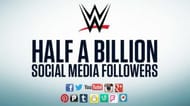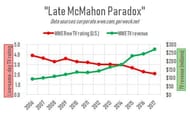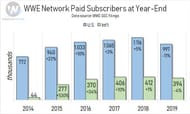
WWE has had an almost monopoly on the professional wrestling industry for almost 20 years. Although AEW has now come up as a viable alternative and has been very successful since its inception, there are still several reasons why WWE is still a global giant. Several indicators show us the same. However, on the flip side, there has been an ostensible decline in WWE popularity. The financials and the stock price of the company are at a relatively low level and other forms of entertainment seem to have gained precedence. But, the question is how relevant and popular is WWE today? We shall try and answer that during this slide show.
#6 The Social Media Numbers

10 WWE Stars Who Are Now Banned - Find Out Now!
Social media is a quintessential part of life in this day and age. WWE happens to have a monster of a presence on almost all Social Media Platforms. At the time of writing, WWE has the following statistics on the most popular social media platforms:-
These numbers are exceptional and more often than not, WWE special events trend #1 worldwide on Twitter. WWE also has had astronomical success on YouTube and that deserves a special mention. WWE has 55.5 million subscribers and almost 40 billion video views. This makes it the world's 7th most subscribed and 5th most viewed non-auto generated YouTube channel. To put the number of Subscribers into perspective, only 25 countries on this planet have a population more than WWE's number of subscribers! Also, as per data available on SocialBlade, WWE's YouTube Channel has grown exponentially over the past couple of years from less than 25 million in early 2017 to more than double of that today. This period did see a general rise in the number of internet users, especially in India due to the advent of Jio which significantly reduced data costs. However, WWE's pace of growth has been more than most other YouTube Channels during this time. For instance, Impact Wrestling grew from just over 2 million to 3.16 million subscribers in the same time frame. All Elite Wrestling has just over a million subscribers today after more than a year of the inception of its YouTube Channel which is great for a new company but, dwarfs in comparison to the 21 million subscribers WWE's channel gained during the same period. This makes WWE a global brand with a massive online presence.
#5 The Television Ratings

WWE's biggest source of income remains to be the television deals for Raw, Smackdown and now NXT as well. Ironically enough, during the same period when its YouTube Channel boomed, its television ratings in the United States have plummeted. WWE Raw averaged 3.018 million viewers in 2017, 2.823 million viewers in 2018 and 2.418 million viewers in 2019. This year, it has averaged 2.321 million viewers so far despite being in the pre-WrestleMania season which is considered a good time for ratings. This represents a decline of 23% over this period.
Smackdown has fared better and has averaged 2.546 million in 2017, 2.366 million in 2018 and 2.251 million in 2019 despite moving to a much bigger channel FOX in October. This year it has averaged 2.514 million viewers which is better from last year but still a 1.25% decline from 2017 despite FOX being in more homes than USA Network. Raw and Smackdown, however, still manage to be the highest-rated program in the coveted 18-49 year old demographic in most weeks.
NXT has been struggling against AEW Dynamite with its 10th straight loss this week averaging just 787,000 viewers since its inception aginst Dynamite's mighty 898,000 viewers.
#4 Positive Financial Indicators

Despite the decline in viewership on television, WWE has however managed to strike good television deals in the USA and India. Although the deal in India grew 80% to about $61 million the growth is pale compared to the one in the USA and also becomes less pronounced as India is a growing and developing economy where prices and income have been on the rise steadily.
The television deals for the USA as estimated here by Wrestlenomics have been around $265 million per year for Raw, $205 million for Smackdown and $30 million for NXT in 2019. The deal for AEW Dynamite was estimated to be worth $45 million in comparison.
Revenues in 2019 were claimed to be $960.4 million by WWE themselves, which were the highest in the company's history. The revenue from the controversial yet, lucrative Saudi Deal was estimated to be $100 million a year while almost $16.9 million came from WrestleMania's ticket revenue. Also, the chairman Vince McMahon has an estimated net worth of $2.1 billion!
All these financial indicators reflect WWE's popularity which is paradoxical given the television ratings. The deals in India and Saudi Arabia are also indicative of its profound international popularity in particular.

#3 Network Subscribers, Live Attendance and Other Not so Impressive Indicators

WWE Network was a pioneer of its kind as it aimed to revolutionalize the pay-per-view business. It was aimed to grow steadily to 3-4 million subscribers by now but has stagnated to below 1.5 million subscribers. This happened despite an unchanged price.
WWE Live Attendance Figures are down as well and so are the merchandise sales. The attendance figures for Stomping Grounds were embarrassingly bad as only 4,000-4,500 people had paid to watch the show in the arena. In the third quarter of 2019, revenue from consumer products declined from $19.6 million in the same quarter in the previous year to $17 million. This includes merchandise sales through e-commerce and at live events.
Most aspects of the 2019 financial report were not positive financial indicators. WWE managed to make up for this to a certain degree from their Saudi Arabia revenue as well as their television revenue. This indicates a general lack of interest in the product.
#2 An Empowered Wrestling Community

Now we come to the non-statistical part of this slideshow. For years, wrestling was viewed as fake fighting and wrestlers and fans were looked down upon. Fans also treated wrestling as more of a guilty pleasure. Today, however, wrestling is perceived as much more optimistically. There is a huge online wrestling fanbase. People engage in wrestling journalism more than ever before and most of us have an opinion about how to book event X or superstar Y. Wrestlers are seen breaking kayfabe and disclosing secrets of their craft, a craft that is being appreciated for what it is now more than ever. WWE, in spite of all the hate it gets, is the largest wrestling company in the world by far and has steered much of this change.
It is now a more family-friendly product promoting women as equals to men and thereby appealing to more people and enabling them to be proud of being wrestling fans. Websites such as this are well known for their WWE content and have a dedicated fan base.
One may argue that this does not explicitly mean it is attracting more eyeballs, but, what it does mean is that the attracted eyeballs are more empowered than ever to watch what they love and express their opinions about it. This has been a change for the better and reflective of WWE's adaptive marketing strategy which has kept it relevant even today amidst all the digital content in the world.
#1 Star Power and Mainstream Appeal?

WWE has created some very well known personalities. Hulk Hogan was a mainstream icon, Stone Cold Steve Austin was legendary and The Rock is the biggest movie star in the world today. Even John Cena has established himself in Hollywood and Kane rather unconventionally won the election to become the mayor of Knox County. WWE always rode on superstardom and larger than life characters. The likes of The Undertaker, the ones mentioned above, Triple H, Batista, and Shawn Michaels were legitimate draws and carried the company.
Today, however, WWE seems to be more interested in promoting itself as an integrated product. The stars it tries to create pale in comparison to ones of yesterday. Roman Reigns is awesome and a real-life inspiration. But, he is nowhere near as popular as John Cena was who in turn was less popular than The Rock and Steve Austin. This is reflected in the fact that Bill Goldberg is the Universal Champion at 53 years old and that Undertaker and John Cena need to be brought back to sell tickets for WrestleMania. Even the entire story about Edge relies heavily on nostalgia and is good in the short run but, shows the company's inefficacy to create stars.
When I was a kid, everyone in school knew who Cena was, who The Undertaker was and who The Big Show was. Watching WWE was not encouraged by parents but, was still fairly popular. Several consumer products such as had WWE related marketing. However, today in college, very few watch WWE and know the current roster. They are empowered and proud and wear t-shirts of their favorite superstars but, hardly ever does wrestling become a topic for conversation. The popularity of Marvel and other digital media has pushed WWE pout of the mainstream and this can be seen as one of the ill-effects of the formation of a separate community of wrestling fans.
To conclude, WWE seems to be in a very different, yet paradoxical situation today. It is still a global giant but does it still have the same magnitude of appeal it used to, but differently? What do you think?
There have been both positives and negatives of this phenomenon and I hope WWE can continue to be the success it is known to be going forward.
Make Sportskeeda your preferred choice for WWE content by clicking here: Source preferences

